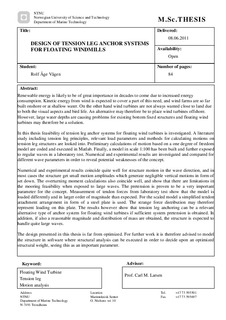Design of tension leg anchor systems for floating windmills
Master thesis
Permanent lenke
http://hdl.handle.net/11250/237970Utgivelsesdato
2011Metadata
Vis full innførselSamlinger
- Institutt for marin teknikk [3421]
Sammendrag
Renewable energy is likely to be of great importance in decades to come due to increased energy consumption. Kinetic energy from wind is expected to cover a part of this need, and wind farms are so far built onshore or at shallow water. On the other hand wind turbines are not always wanted close to land due to both the visual aspects and bird life. An alternative may therefore be to place wind turbines offshore. However, large water depths are causing problems for existing bottom fixed structures and floating wind turbines may therefore be a solution.
In this thesis feasibility of tension leg anchor systems for floating wind turbines is investigated. A literature study including tension leg principles, relevant load parameters and methods for calculating motions on tension leg structures are looked into. Preliminary calculations of motion based on a one degree of freedom model are coded and executed in Matlab. Finally, a model in scale 1:100 has been built and further exposed to regular waves in a laboratory test. Numerical and experimental results are investigated and compared for different wave parameters in order to reveal potential weaknesses of the concept.
Numerical and experimental results coincide quite well for structure motion in the wave direction, and in most cases the structure get small motion amplitudes which generate negligible vertical motions in form of set down. The overturning moment calculations also coincide well, and show that there are limitations in the mooring feasibility when exposed to large waves. The pretension is proven to be a very important parameter for the concept. Measurement of tendon forces from laboratory test show that the model is loaded differently and in larger order of magnitude than expected. For the scaled model a simplified tendon attachment arrangement in form of a steel plate is used. The strange force distribution may therefore represent loading on this plate. The results however show that tension leg anchoring can be a relevant alternative type of anchor system for floating wind turbines if sufficient system pretension is obtained. In addition, if also a reasonable magnitude and distribution of mass are obtained, the structure is expected to handle quite large waves.
The design presented in this thesis is far from optimized. For further work it is therefore advised to model the structure in software where structural analysis can be executed in order to decide upon an optimized structural weight, seeing this as an important parameter.
